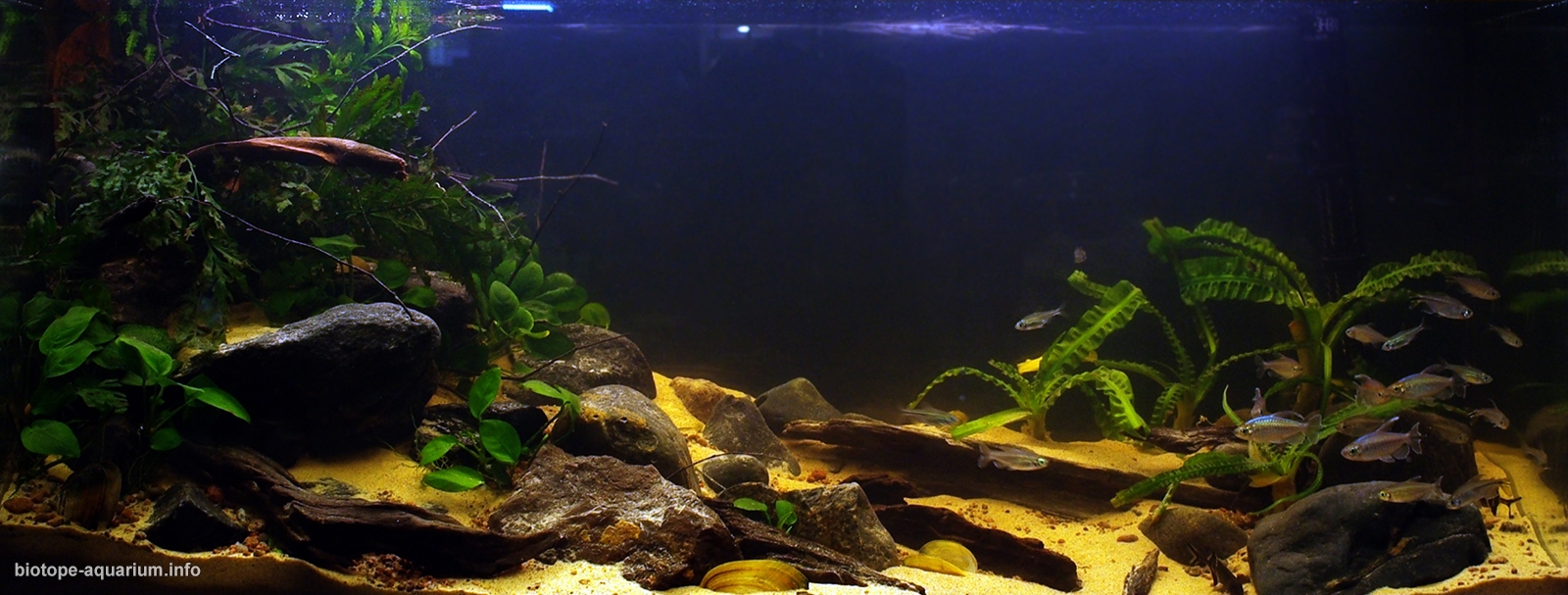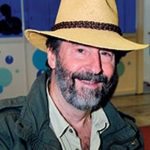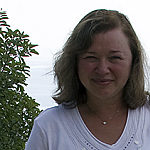Malebo pool, above Kintele, coastal area, Republic of the Congo
The 4th place in the final of the Biotope Aquarium Design Contest 2013
![]() Russia. Vera Gladyshenko
Russia. Vera Gladyshenko

Volume: 180 L
List of fishes: Phenacogrammus interruptus, Hemigrammopetersis caudalis, Gnathonemus petersi, Synodontis angelicus.
List of plants: Bolbitis heudelotii Anubias barteri var. nana, Crinum natans.
Biotope description: Not far from Livingstone Falls, upstream, fast, powerful and rocky Congo River expands to Malebo Pool with a total area of about 500 km2, with depths ranging from 3 to 10 m variable on 3 m throughout the year. In the center of the pool there is Mbamu Island, around it there are a lot of sandy, grassy islands, separated by dark water. But there are also rocky areas there, richly covered with boulders. At the bottom there is light sand. There are very little plants, few branches there. Semisubmerged Bolbitis heudelotii, Anubias can be found rarely. Along the edges of Malebo Pool there are a lot of fishes. Each of them has its own niche.
Vera’s comment about the contest: The biotope contest is a real gem of all such contests. It is original, useful and encourages interest of not only the participants but also the audience. Bringing to life the final five aquariums it continues the tradition: teaches the viewer how to keep fishes logically and correctly. Fishes need their natural environment to be simulated. This year we seemed to be prepared remembering all the mistakes of the past. And despite some little defects we created! This process makes us unite, and now we can say that we got new friends, went to the next level and move on the new road, because in front of us there are so many interesting things, so much can be done by applying the invaluable knowledge and experience gained in the biotope contest! Thank you!

Very well done, description is perfect and also the species (plants and fishes), my compliments.If I had to judge Vera you would have had 2nd, fractions away from 1st. My compliments.

In my opinion it is one of the best entries of the biotope contest: nature like design, good selection of fishes and plants. Thanks to well-formed coastline, rocky-sandy bottom, well-positioned plants it seems as if a small piece of the river has been taken from the wild nature and put in the aquarium. Everything looks very natural and harmonious. Due to the successful composition, the author managed to expand visually the space of the aquarium. It’s a pity, the photo is not very good and does not show the full depth of perspective, which the author managed to create in a relatively narrow space. Width of the aquarium is only 40 cm. I think one kind of tetras would be enough, but they should be more. One species of fish in a large school feel more confident and look very impressive. It’s a pity the fishes had stress a little and did not demonstrate all its natural beauty, probably because of the long transportation. But nevertheless it is a great aquarium, too bad it was only on the fourth place.

In terms of identity it is the most biotope entry in the contest. Light mist in the water does not spoil it. Everything is correct and concise here. Nothing is excessive. My general recommendation to all participants for future contests: get fishes you will show in the final in advance. Not later than one month before the contest. Fishes just put in aquariums after long journeys can not feel well for a couple of days. Hence we have unnatural behavior and unexpected death. According to the experiments of scientists, it takes fishes that are strong, resistant to stress and having rest after transporting (carps, cichlids) at least 4-6 hours for acclimatization in the new conditions, and only after that the fishes begin to behave like in nature. And what can we say about stressed fishes, such as elefant nose? Of course, they did not acclimatize and behaved completely unnatural. In nature, as in aquariums Gnathonemus stay together all the time (they are schooling) and are daily active, occasionally resting (mainly afternoon) somewhere in the thickets of plants. Nevertheless, this entry could deservedly got 1st place, but was 4th, apparently because of the concise setup. I forgot to add: the exact name of blue tetras is Alestopetersius caudalis.
